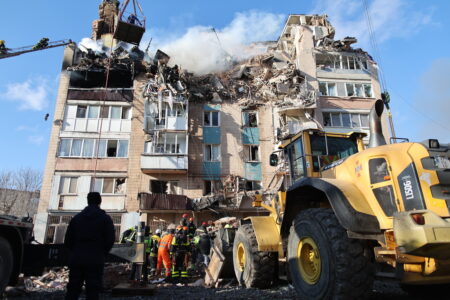Other communities oppose EP wastewater as village considers accepting it
EAST PALESTINE — As East Palestine Village Council continues to consider a proposal presented by Village Water Superintendent Scott Wolfe to accept and discharge a percentage of the treated derailment water from the newly operational wastewater treatment facility constructed by Norfolk Southern, other communities in Ohio are expressing opposition to receiving it.
Local officials in Coshocton voiced concerns about the Buckeye Brine facility receiving the water from the derailment. The injection well facility, where non-hazardous wastewater is injected into confined geological formations more than 1-mile below the lowermost drinking water aquifer, announced Aug. 31 the intention to take on some of that wastewater.
Coshocton County Commissioners and the City of Coshocton both objected to the plans, and in press releases, both said they would be reaching out to state and federal elected officials for assistance and to consult with the Ohio and federal EPAs on the matter, the Coshocton Tribune reported. The commissioners have also sought consultation in an attempt to legally block Buckeye Brine from accepting and injecting the derailment waste. Coshocton Environmental and Community Awareness recently held a public meeting at the Coshocton County Career Center, drawing more than 200 people, to also discuss ways to squash the plans to accept East Palestine wastewater and call for protests and demonstrations in front of the facility.
This isn’t the first time outside municipalities have opposed the acceptance of derailment waste by facilities. Three weeks after the rail disaster, residents in Harris County, Texas, also voiced concern about the Houston-area Texas Molecular accepting the water used during the firefighting efforts in East Palestine.
Concerns were also raised by local officials in Romulus, Michigan, when it was announced the town’s Republic facility would accept derailment wastewater. In March, Baltimore council members unanimously adopted a resolution to urge the EPA to reverse the plan to bring the water to the city. In May, it was reported that Clean Harbors would treat the water but it would be shipped back to the company’s Cleveland facility for disposal.
Although little to no concerns were expressed by residents living near the Cleveland Facility, 60 miles away in Sandusky, it was a different story, as residents, including Ohio State Rep. Gary Click scrutinized Vickery Environmental treatment of liquid derailment waste. States have also refused to accept contaminated soil from East Palestine. Michigan, Oklahoma and Texas all attempted to turn away waste and only relented when EPA Federal administrator Michael Regan called blocking any shipment from East Palestine under the Comprehensive Environmental Response, Compensation, and Liability Act (CERCLA), commonly known as Superfund. Locally, the decision to incinerate some of the waste at Heritage Thermal in East Liverpool drew sharp criticism.
The Environmental Protection Agency (EPA) last updated that 113,873 tons of solid waste has been shipped off site for disposal and 33,332,968 gallons of liquid waste shipped and disposed of.
However, the wastewater treated at the Norfolk Southern facility, while still considered waste, would also be considered non-hazardous. Once treated the water would be, according to the EPA, rendered to “drinking water standards.” To accomplish that, the facility utilizes a sophisticated process designed to remove vinyl chloride and other derailment contaminants from rainwater that has come into contact with contamination. The system uses several steps — including sedimentation, filtration, oil-water separation, air stripping and activated carbon –to remove suspended solids and particles, oils, volatile organic compounds (VOCs) and other remaining site contaminants.
Treated wastewater samples are collected to verify the system is working as planned. The treated wastewater is then stored in large tanks and tested to verify the vinyl chloride is below the drinking water standard. Norfolk Southern will then identify off-site non-hazardous disposal facilities to accept the treated wastewater. Until the construction and approval of the wastewater facility, derailment wastewater was held in two million-gallon tanks until it can be shipped off site to facilities approved by the EPA to accept and treat toxic water.
If the East Palestine municipal wastewater plant does accept some of the treated water, the village would be compensated for it. Under Wolfe’s proposal, some of the wastewater would be piped into the East Palestine wastewater plant via a series of pumps and a hard tap-in to the village’s sanitary lines by Norfolk Southern. Wolfe said the water would be “very clean” and while the village does not have the capability to take all the water, taking some of it would reduce the truck traffic on the village roads. He went on to explain the process in which the village would utilize to accept only a certain amount of the discharge. The early plans are to use a VFD (variable frequency drive) that would effectively work as a throttle. The water would then be treated again at the municipal plant before being discharged into the waterways.
Council is yet to announce a decision on the proposal or schedule a public meeting to obtain public feedback on the issue, but addressed the idea of accepting wastewater on the village’s East Palestine Information page. In a statement, the village said it is following EPA guidance on the matter and stressed that the “already-treated water would be treated a second time before it is released.” The statement also listed reduced truck traffic as “an advantage” to accepting the proposal but listed no disadvantage.
Ultimately, the decision rests on the village as Ohio EPA Water Quality Supervisor Bill Zawisk explained during the Aug. 28 council meeting. Zawisk said that while an additional permit is needed in order for NS to discharge directly into the village sanitary lines, permission from East Palestine will make or break the plan.
“There’s a real distinct process in how this works,” he said. “To discharge to the sewer they have to have two things — they have to have a permit from us and, the second thing is, independently from whether we issue a permit or not, they need your permission to tie into the sewer.”




